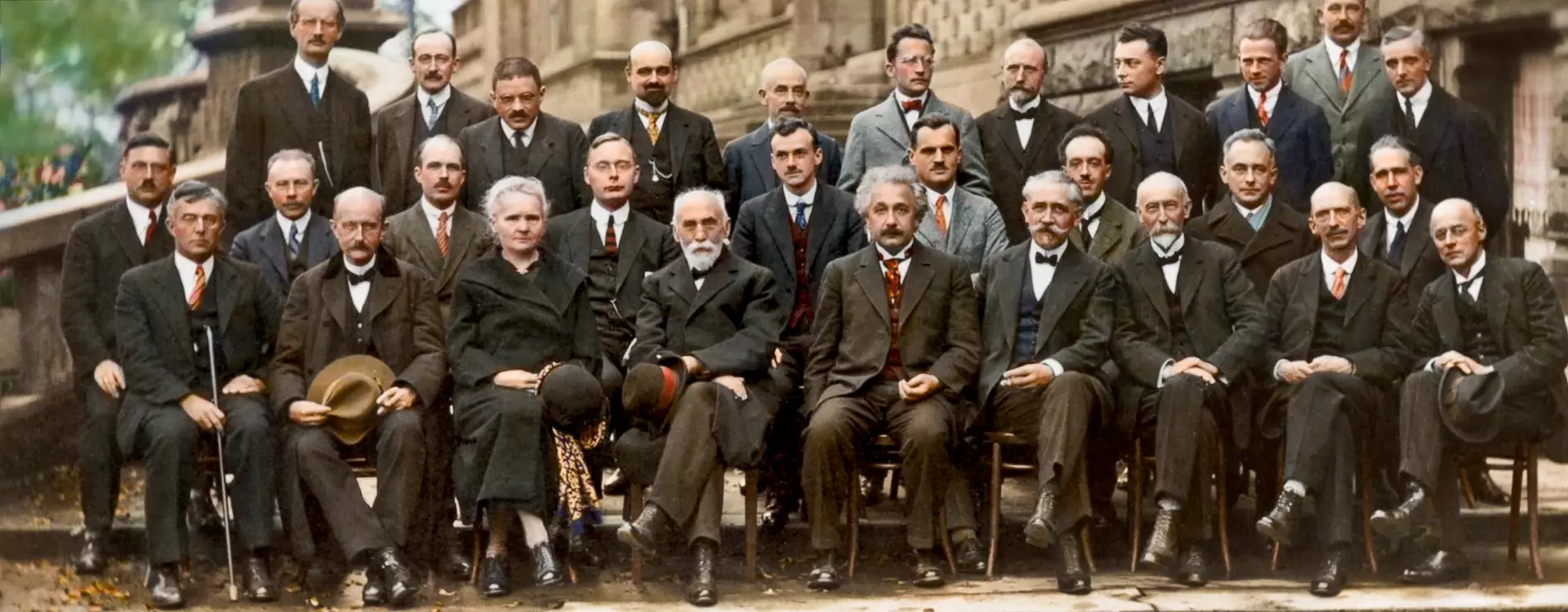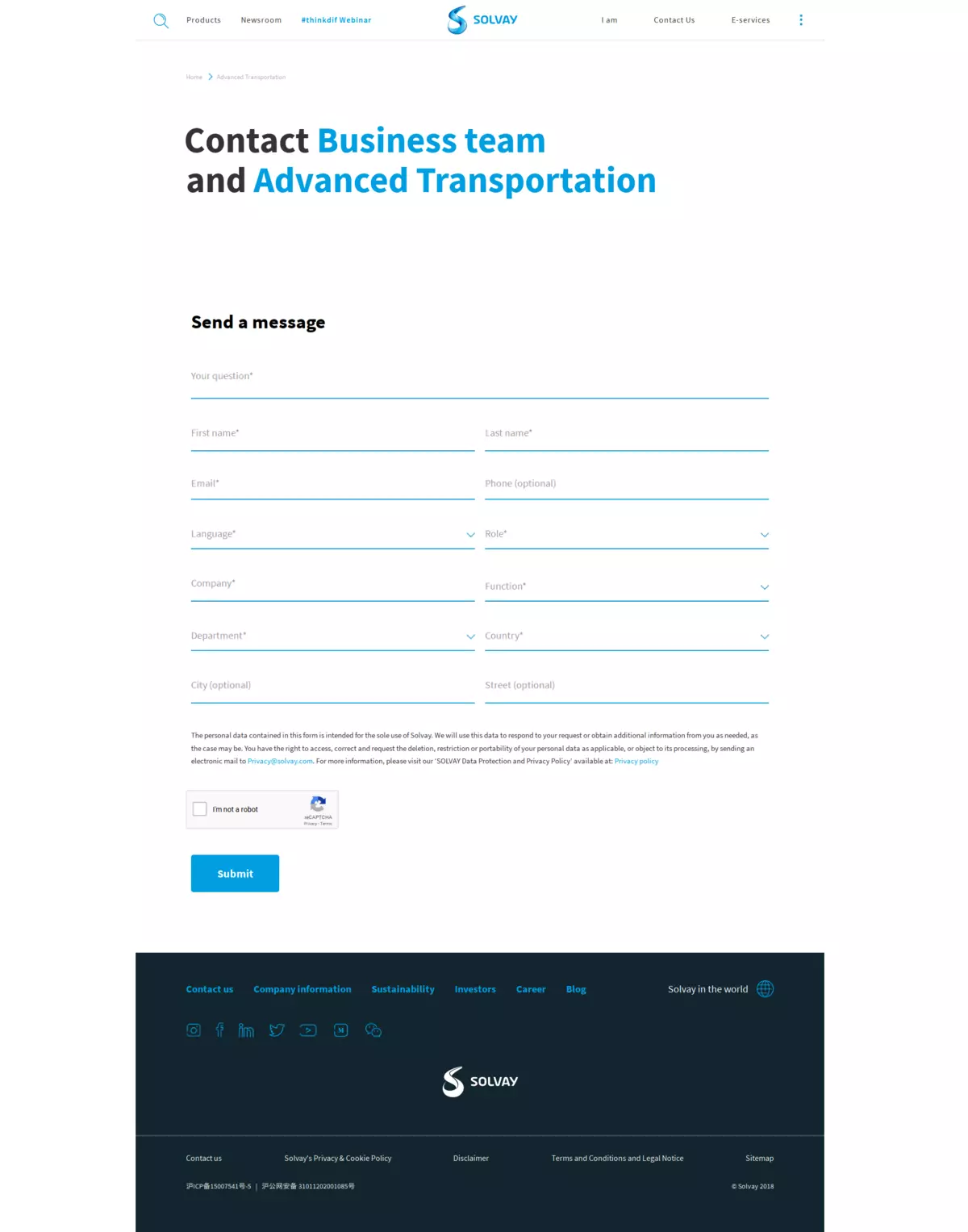
Solvay
An international reaction
Corporate site of Solvay Group, a big chemical company.
What is Solvay Group?
The Solvay Group, headquartered in Brussels, is a large chemical company with more than 135 workplaces in 61 countries and employs more than 25,000 people, and until September 2018 one of the companies in the CAC40 index, the French equivalent of the IBEX 35.
The company has its origin in 1863, founded by Ernest Solvay, thanks to the discovery of a process to obtain sodium carbonate in a much more efficient way than the processes of that time. Thanks to this procedure Ernest Solvay was able to raise a large business group, without forgetting a philanthropic component from which emerged the well-known Solvay Conferences, congresses held from 1911 to the present. In the congresses of the beginning of the 20th century, the greatest scientists of the time such as Albert Einstein, Marie Curie, Ernest Rutherford, Erwin Schrödinger, Niels Bohr or Werner Heisenberg met, and in them the future of Physics and Chemistry of the time was defined, treating with heated discussions topics such as novel and still not very intuitive quantum mechanics.

The goal
Solvay is a large company with special needs for its brands' websites. Not only does it need a main website to show its general information, but it also requires websites for each of the countries in which it has a strong presence, with different functionalities, not forgetting websites for each of the most important products and brands it offers to its customers.
Of course, the sites had to be multi-language, have a good user and permission system to segment content contribution and website administration, integration with internal information services, an advanced search and great possibilities in terms of content layout, without forgetting the basics of a modern website such as responsive design or adjustments for SEO.
An international team
Solvay decided to count on other companies that could give the best service for their big project. Mirum, as a digital agency, would be in charge of coordinating the project and providing creativity and design. Metadrop would cover all the technical part of development and project management. And finally, Acquia, the Drupal creator's company, would provide its hosting infrastructure and ensure the proper technical development of the project.
The project has been developed between several countries and teams, with the main development based in Madrid, initial project meeting in Paris and training of Solvay's technical team in Singapore.

A unique code to dominate them all
Acquia's proposal was to use Acquia Cloud Site Factory or ACSF. This Acquia web hosting solution for Drupal allows you to create hundreds of sites and manage them from the ACSF console. The idea is that each site is installed using any of the Drupal profiles available in the project sources, so they all share a single code base that is updated and managed as a single package. ACSF is itself a hosting solution with different environments (development, testing, UAT and production) managed by Acquia with facilities to deploy new releases, perform certain operations and system functionalities (such as logging into the different sites by an Acquia user, backups on demand, proxy cache, load balancers, multiple webheads, etc).
This type of hosting is designed for large organizations that need many different websites but with a common base. For example, international companies having per country websites with enough staff for each country to manage its own website, but with a centralized technical control. With ACSF you can create a new site by simply indicating in your web console the domain and the profile to apply, having a new site ready in minutes. At the same time, since it is a Drupal multi-site configuration, all the sites are updated at the same time by updating the common codebase.
The development
The Solvay project has made us face different difficulties as well as the deepening in certain methodologies according to the scope of the project:
- Data import from Tridion: One of the requisites was the import of the previous website sections into the new Drupal-based website. Given the amount of data to import it was not reasonable to do it manually or semi-automatically. For this, we had to handle large exports of a content manager totally unknown to us, Tridion SDL. The data was imported into Drupal thanks to our work configuring and extending the excellent Migrate module of Drupal 8.
- API creation for products: Solvay is a company with an extensive catalogue of products that they manage internally but they must be updated in the main web. For this reason, an API REST was developed to allow automatic updating and management of products and associated data, based on contributed modules and own development to facilitate integration.
- Integration with own API: Some information is retrieved from Solvay's own API that had to be implemented and integrated in Drupal.
- Advanced search with Solr: One of the interests of Solvay for this website is that visitors find relevant information quickly and easily. A search system based on Solr and Drupal views was designed, with its own code to accommodate the specific characteristics of Solvay.
- Multi-language: Although the web is not totally multi-language, there are sections that are. But above all, a solid base is needed for the rest of the webs that will come later, which are completely multi-language. This is why the web internally supports multi-language content and translation of the contents and interface of the web, as well as specific tweaks for certain needs that were far from the standard operation of Drupal's internationalization modules.
- Creation of complex contents by use of components: Content editing is not just fields and free text, but, depending on the creative needs of the content team, a developed series of components that can be used in any content that needs them. In this way, editors only have to select the type of component they want to insert and complete the specific fields for that component.
- Integration with an external DAM (Keepeek): As a large company offering many possible digital channels, Solvay makes use of a DAM (digital asset management), Keepeek in this case. It was required that the images and videos could be embedded (and most of them are) from Keepeek, but offering all the Drupal functionalities (image styles, use in fields, etc).
Integration with CRM: Salesforce is almost certainly the most widespread CRM today. Integration with this CRM has been required to send web-generated customer information, mainly leads.
Acquia Cloud Site Factory: ACSF is a powerful tool, but recently created by Acquia so we had no experience with it. It requires the use of Acquia BLT, and the operation flow is not trivial, so we had to adapt to its use without delaying the development of the project. The advantages are that once assimilated, both ACSF and BLT help to a more solid and faster development.
Functionalities structured in profiles: Since ACSF allows to create sites using one profile, the project required the creation of several profiles for each type of site. Although for this phase only one is used (the main site), it was necessary to plan the profiles structure for the future, thanks to the functionality provided by Lightning inheritance in profiles (similar to the creation of sub-themes, but with profiles, functionality that is being added to the core of Drupal 8).
Development based on branches and PR: Metadrop has been developing for a long time using branches for each intervention in the code, be it new functionality, bug fixes or any other change. In this case, it was just on a bigger scale. Different main branches have been used (development, release, master), a production delivery flow that required validations from several teams (external technical review, confirmation of functionality by different people and several companies involved, etc), code review in each PR, internal and by Acquia, and many other small things derived from leading the development of a large project.
Continuous Integration System: All of the above would not be easy without a Continuous Integration system, responsible for testing and performing static code analysis for each branch pushed to the central repository. This assures us that nothing breaks with new commits and provides additional information when doing code reviews.
An international team with different time slots: Coordination between teams has been an additional challenge due to the number of people involved and different time zones (from Spain to Singapore). Thanks to the project's communication tools and the use of the agile methodology this could be handled without major problems.
Agile: We are particularly proud of the way we have implemented the agile methodology, both internally and in the relationship with the customer, absorbing in a flexible way the changes of unexpected requirements, contingencies and other incidents avoiding overworking or increasing the budget, simply managing the delivered functionalities and the product expectations.
Future
We believe that we have created a solid base on which to build the next phases of the project. On next steps, we will refine the profiles and create the multiple sites that the Solvay constellation sites will be made up as they have projected. In Metadrop we love the challenge and this is a great opportunity to continue learning, growing and improving our way of working.
Fifth Solvay conference picture by Benjamin Couprie. Solvay office picture by Jean Michel Byl. Paris picture by Taxiarchos228 user in Wikimedia Commons.






